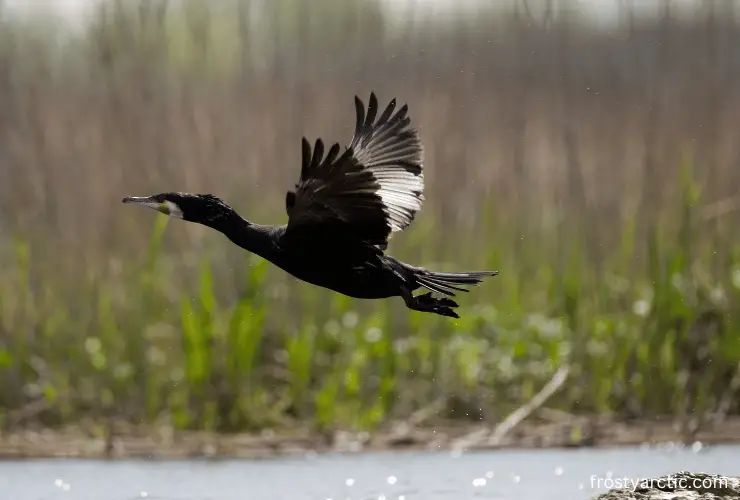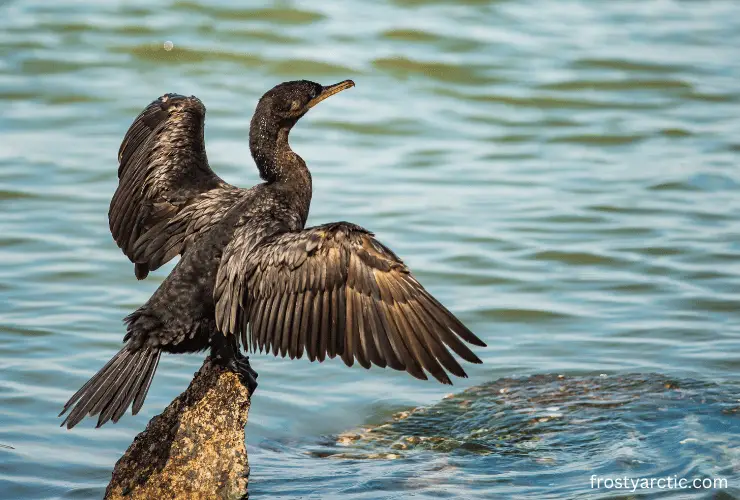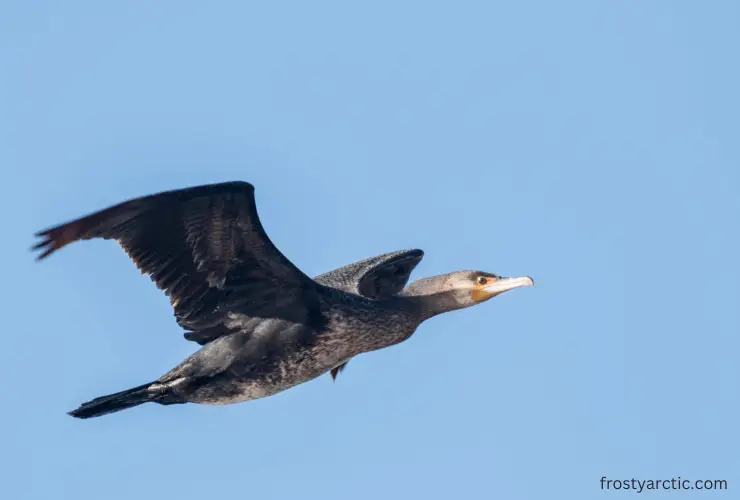Yes, cormorants can fly. These birds fly in flocks in irregular line formations or haphazard V’s. Cormorants fly at medium speed because of their unique flapping style. The highest recorded rate for cormorants is about 54 km/h over long distances.
Did you know that the word cormorant is a contraction of the Latin words Corvus Marinus, which means “sea raven?” This article covers some fascinating characteristics of these birds. So, without further delay, let’s get started!
Do Cormorants Fly? How Far Can Cormorants Fly?
Yes, most cormorant subspecies can fly. Research suggests they can fly at a maximum speed of 35 mph.
Did you know? Nearly all cormorant species can fly except for the flightless cormorant also known as the Galapagos species. Studies revealed that evolutionary pressures have contributed to their inability to fly. ~ UCLA Health
But how far can cormorants fly?
There needs to be more research on the distance these birds travel in unbroken flights. However, evidence suggests that they can travel several hundred kilometers.
Some scientific evidence indicates that the birds can fly nearly 600 km without rest from the Austrian Danube to the Italian Adriatic. The duration of this unbroken flight is about 12 hours.
A study conducted on the feeding flights of cormorants showed that they flew an average minimum of 2 km and a maximum of 40 km from Cat Island in Wisconsin. They flew an average of 2.4 km to 12 km from Spider Island. ~ THOMAS W. CUSTER and CHRISTINE BUNCK
How High Do Cormorants Fly?
Cormorants can fly at a mean height of 8.3m at a wide range between 1 to 150m. Other research indicates that the majority of the birds flew at a height of fewer than 5m at Egmond aan Zee. ~ Aonghais S.C.P. Cook, Alison Johnston, Lucy J. Wright & Niall H.K. Burton
A set of 17 studies were conducted on more than 20,227 Great Cormorants in fourteen different areas.

They showed that the flight heights significantly varied between birds in offshore wind farm zones.
4% of the birds in Kentish Flats flew at altitudes between 20m and 150 m. on the other hand, at Gunfleet Sands, this proportion was about 33 %.
Another research conducted on the flight height of local seabirds found that most cormorants flew up to 100 m and sometimes even higher. ~ Flight height of seabirds. A literature study
Do Cormorants Fly at Night?
Because most seabirds rely on sight for hunting, they are significantly influenced by varying light intensities.
This makes hunting extremely problematic, especially for animals living at high altitudes during the Polar nights.
A study conducted on great male cormorants during the Polar night revealed that birds hunt even during the nighttime. These black birds did not adjust their foraging activity in response to the varying day lengths. ~ NIH.gov
Why Do Cormorants Fly Close to The Water?
Cormorants are often observed flying low on the water’s surface. It allows them to take advantage of the ground effect, an aerodynamic phenomenon that minimizes air resistance while flying.
During a flight, the higher a bird goes, the more air resistance it is likely to experience.
Skimming over the water modifies the air pattern around the wing in such a way that it reduces resistance. ~ Stanford.edu
Cormorants also require more energy to fly compared to the average seabird. This is because of their short wings that work better as rudders. Hence, they fly near the surface of the water because it requires less effort.
Can Cormorants Fly When Their Wings Are Wet?
Most birds’ feathers are waterproof because of their unique structure. However, cormorants’ feathers are easily waterlogged. This feature contributes to easier diving but makes it difficult for them to fly.
Water-logged feathers increase swimming efficiency while reducing the bird’s buoyancy.
Because of their heavy bones and waterlogged wings, these animals cannot fly as smoothly as other seabirds. ~ Source
Both of these adaptations allow Cormorants to easily hunt for prey underwater.
Do Cormorants Fly In Formation?
Yes, cormorants fly in a V formation while traveling long distances as a flock. It is a common flight behavior for these black birds, especially during continuous travel over long distances.
During October, you might find a cormorant flock flying in an irregular V formation. Compared to Canada Geese, their formation could be more organized.
Do Cormorants Fly South for The Winter?
Not all cormorant populations fly south for the winter. It depends on the area they are living in. Migration patterns for different populations are listed below:
- Western populations: migrate to the Pacific coast
- Northern Atlantic Coast populations: migrate to the southern and southeastern U.S
Did you know? Some cormorant populations do not migrate at all. Cormorants living in Florida, the coastal Pacific Northwest, and coastal Mexico stayed in the southeastern U.S. throughout the year. ~ D. Tommy King, Bronson K Strickland, and A.A. Radomski.
Movement data of these magnificent black seabirds showed that the Arkansas, Louisiana, and Mississippi cormorant populations moved towards the north along the Mississippi River Valley.
On the other hand, the cormorants living in France have shown an increase in winter migration. Observations recorded have shown that about 25% of the adults and 19% of the first-year birds moved northeast. ~ Source
What Sounds Do Cormorants Make?
When alone, cormorants rarely ever make any noise, but when they are a part of a colony, you will hear grunting sounds that sound a lot like the oinking of a pig.

These birds make deep guttural sounds in a sequence, making them sound quite like pigs.
The double-crested cormorant grunts during mating or while taking off and landing. Otherwise, they are generally tranquil creatures. ~ All About Birds
Do Cormorants Have Good Hearing?
Most birds rely on their sense of hearing for auditory information and to detect the presence of prey and predators near them. Among these birds, nearly 10% hunt for food underwater.
Cormorants are one of the most well-known marine predators that feed on aquatic animals throughout the year.
Research suggests that cormorants have low visual acuity underwater. So, they rely on underwater hearing to catch prey. Results have shown that their hearing sensitivity is much higher underwater than in the air. ~ PubMed
2 kHz was the greatest sensitivity found for cormorants underwater. This falls a hearing threshold of 71 dB re 1 μPa rms, a hearing threshold comparable to seals and toothed whales.
In other words, aquatic birds, including cormorants, have specific adaptations for underwater hearing. ~ Source
Where Do Cormorants Sleep at Night?
When asleep, cormorants are most likely to be attacked by predators. This makes it essential to choose a safe nesting area carefully.
Most cormorants live in places where aquatic animal supply is abundant. But where do they sleep at night?
Cormorants spend the night in communal sleeping roosts on smaller ponds and lagoons in the winter season. Then, they fly to the feeding area, usually nearly 40 miles away.
They nest on low cliffs and in colonies near the coast or on trees located on lakes.
Over time, the accumulation of cormorant guano kills the trees, which causes them to collapse. At this point, cormorants switch to nesting on the ground. ~ All About Birds
FAQs
Do cormorants dry their wings?
Yes, cormorants dry their wings either on the rocks or sitting on the trees. They open their wings in the sun to ensure they dry effectively.
Why do cormorants hold out their wings?
Cormorants do not have sufficient balm in their preen glands, making their wings non-waterproof. So, they have to spread their wings out to dry them.
What is the natural predator of a cormorant?
The natural predators of cormorants are larger predatory birds, including eagles, crows, and gulls. They hunt cormorant young and eggs.
Conclusion
Although they are weak at flying, cormorants are exceptional divers and can dive to a depth of 45 meters.
Their webbed feet and easily wetted wings help them dive deep into the sea to hunt. These characteristics facilitate swimming but make it harder for them to fly.
I hope this article answered your question about whether cormorants can fly and provided ample details on the flight characteristics of cormorants.


